The Coast of Georgia stretches for about 100 miles, with Savannah to the north and the wild horses of Cumberland Island to the south. There are 5 beautiful lighthouses on Georgia’s coastline. There is a gap of several miles between the mainland and the barrier islands. This area is filled with tall marsh grasses and is named the “Grass Seas“. This marshy area stretches out as far as the eye can see! Beneath these grasses is a layer of dense mud, deep enough to swallow up a ship!
5 Lighthouses in Georgia
You will find 5 lighthouses on the coast of Georgia;
- Cockspur Island Light
- Tybee Island Light
- Sapelo Island Light
- St. Simons Island Light
- Little Cumberland Island Light
The Marshes of Glynn
**Fun Fact: The poem by Sidney Lanier, “The Marshes of Glynn”, was written about the marshes in Glynn County, GA. You can read more about it by clicking on the link below.**
The Marshes of Glynn Sidney Lanier - 1842-1881 The creeks overflow: a thousand rivulets run 'Twixt the roots of the sod; the blades of the marsh-grass stir; Passeth a hurrying sound of wings that westward whirr; Passeth, and all is still; and the currents cease to run; And the sea and the marsh are one.
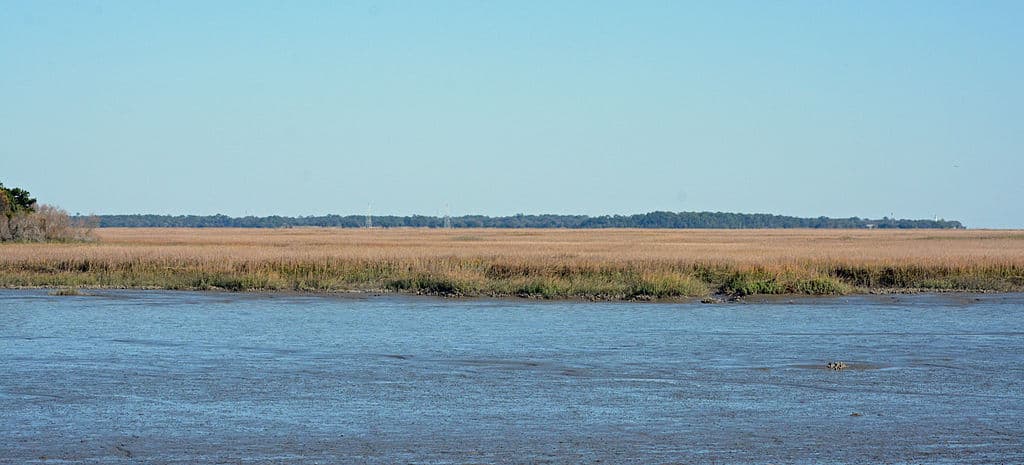
Cockspur Island Light

**Fun Fact: A day-mark is a marker or lighthouse without a light, it can only be seen during the day.**
The Cockspur Island Light is located on an oyster bed(islet) off the southeastern tip of Cockspur Island marking the entrance to the South Channel of the Savannah River. It is the smallest of Georgia’s lighthouses at only 46 feet tall. The Lighthouse stands just 12 miles east of the Port of Savannah. As you can see from this photo the islet is often covered by high tide.
The lighthouse was originally built as a day-mark. The first brick tower was built on Cockspur Island in the late 1830s. Unfortunately, it was destroyed by a hurricane in 1854. The second tower was larger and built on the same foundation the following year.
In 1862, Union Soldiers bombarded Fort Pulaski with the lighthouse in direct line of fire during the Civil War. Miraculously, the lighthouse survived with only minor damage.
The light was extinguished in 1909 since the South Channel was no longer heavily traveled. The National Park Service took over maintenance of the lighthouse in 1958 and 2000, portions of the lighthouse were restored. The Lighthouse was ceremoniously relit in 2007 and remains lit today, although, it is not actively used to guide ships.
ACCESS: The lighthouse is currently not open to the public but the goal is to re-open it in the future. However, an overlook trail offers the best chance to get a closer look at the lighthouse today.
*If you would like to receive more information about travel destinations, campground reviews, and our daily adventures, please click HERE. When you provide your email address, you will receive our weekly newsletters directly in your inbox! We also have a free printable for you!*
Tybee Island Light

Tybee Island Lighthouse is Georgia’s tallest lighthouse with 178 steps to the top. General James Oglethorpe, Governor of the 13th colony, ordered a day-mark to be built. The first day-mark was completed in 1736. It stood ninety feet tall and was the tallest construction of its kind in America at that time. Storms took their toll on the first day-mark and five years later it had to be replaced. In 1742, the second day-mark was completed, but by 1748 the sea was within 30 feet. A new day-mark was needed and time was running out! It took until 1773 for the new lighthouse to be built on a new site. The 100-foot tall lighthouse was lit for the first time. But once again, the Civil war took its toll. Confederate soldiers destroyed the wooden steps and set fire to the lighthouse to prevent Union soldiers from using it to guide their ships. The new lighthouse, the one that stands today, was built with only masonry and metal to make it fireproof.
The Tybee Island Light Station is one of America’s most intact light stations, having all its historic support buildings on its three-acre site.
ACCESS: From Downtown Savannah take Hwy I-16 to US-80E/Islands Expy, follow the signs to the Lighthouse. Free Parking is available if you purchase a ticket. Your ticket includes admission to the Light Station, a Tybee Raised Cottage, and the Tybee Museum in Battery Garland.
Cost: Adults – $10, Seniors – $8, Children(6-17) – $8, and Children 5 and under are free
Hours: Monday – Sunday 9:00-4:30, they are closed on Tuesdays
Sapelo Island Light

Sapelo Island is located 5 miles off the mainland. Most of the island remains natural, with tall marsh grasses, pristine beaches, and coastal forests.
The island was originally home to Spanish missionaries along with French and English settlers. Thomas Spalding purchased most of the island in 1802. Spalding established a plantation on the island, growing sea cotton, sugar cane, and rice.
In 1816, for the sum of $1, he sold five acres on the southern end of the island for the construction of a lighthouse. The first lighthouse was activated in 1820, it served as a guide for mariners crossing Doboy Sound to and from the Port of Darien. The town of Darien is located at the mouth of the Altamaha River. In 1855, a second beacon light(the front range light) was constructed to work with the Sapelo Lighthouse to help mariners find the proper channel for entering Doboy Sound.
Confederate soldiers removed the lighthouse lens during the Civil War before the Union soldiers arrived and occupied the island in 1862. Following the war, the lighthouse and keeper’s dwelling needed extensive repairs which were completed by 1868.
After the war, several free slaves returned to the island and established a settlement on 434 acres of land deeded to them by the Spaldings. The settlement was named Hog Hammock, after Sampson Hog who served as caretaker for Spalding’s hogs.
In 1898, a hurricane caused damage to the lighthouse and the island. After the storm, the sea was becoming dangerously close to the lighthouse, so in 1899 a new Lighthouse and keepers dwelling was constructed farther inland. The original lighthouse and keepers dwelling was crumbling from the storm damage. The dwelling was demolished and the bricks were used to stabilize the old lighthouse. In 1904, and a 100-foot steel tower was built a few hundred feet north of the brick tower.
The skeleton tower served alongside the old brick lighthouse until 1933, when, due to declining shipping in the area, it was dismantled and shipped to Michigan, where it can still be seen today.
In 1969, the northern part of Sapelo Island was sold to the State of Georgia and became the R.J. Reynolds Wildlife Refuge. The original brick lighthouse was eventually restored in 1998.
**Fun Fact: Hog Hammock is still home to about seventy people, many of whom are descendants of slaves who worked on Sapelo plantations. The community is one of just a few sites that preserve the Gullah culture and language.**
ACCESS: Today, visitors can take a tour of Sapelo Island, which includes a ferry ride to the island and a chance to see the marine institute, Hog Hammock, the Reynolds Mansion, and the lighthouse,
St. Simons Island Light
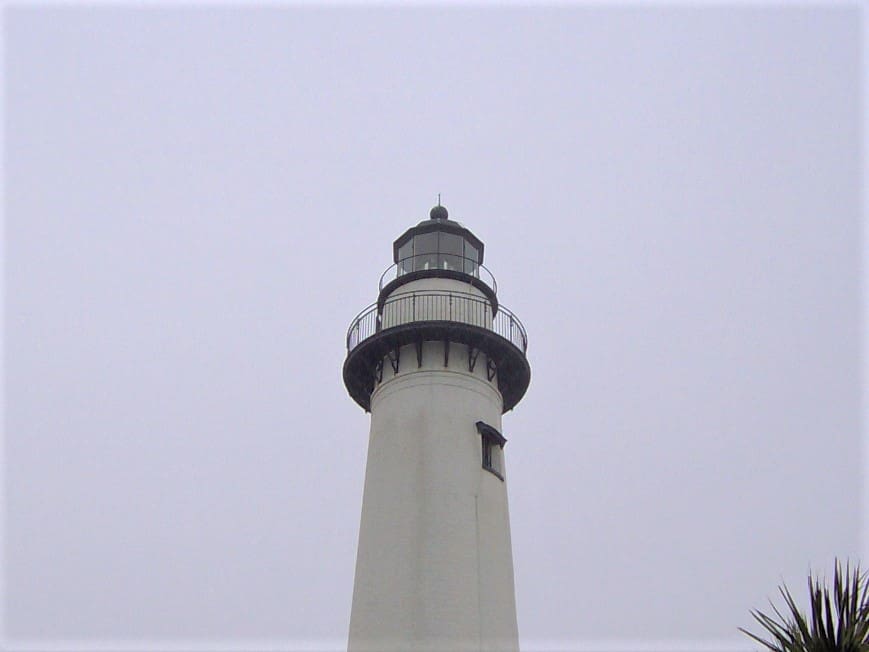
St. Simons Island lighthouse is on the southern tip of the Island, it guides ships into St. Simons Sound.
The original lighthouse was built in 1810 and was 75 feet tall. Like many other Southern lighthouses, it fell victim to the Civil War. The fleeing Confederate soldiers destroyed the lighthouse to prevent the Union from being able to guide their warships through the sound. In 1872 a new lighthouse was constructed to the west of the original location, it was 104 feet tall and made of brick. It had a cast-iron spiral stairway with 129 steps leading to the top.
The US Coast Guard now maintains the lighthouse which is still an active navigation aid today. The latest renovation was in 2010, it was completely repainted inside and out, and some of the iron stair rails were replaced.
**Fun Fact: The lighthouse is haunted! The ghost of a former lighthouse keeper, Frederick Osborne, has been seen climbing the stairs. He died in a duel with his assistant lighthouse keeper, John Stephens in 1880. Apparently, the duel was over unwanted advances from Stephens toward Osborne’s wife.
ACCESS: You can tour the museum for a fee and climb the 129 steps to the top. The lighthouse is located at 101 12th Street
St. Simons Island, GA, it’s open Monday – Saturday 10:00 – 5:00 and Sunday 12:00 – 5:00. Admission is $12 for adults and $6 for children(6-12)
Little Cumberland Island Light
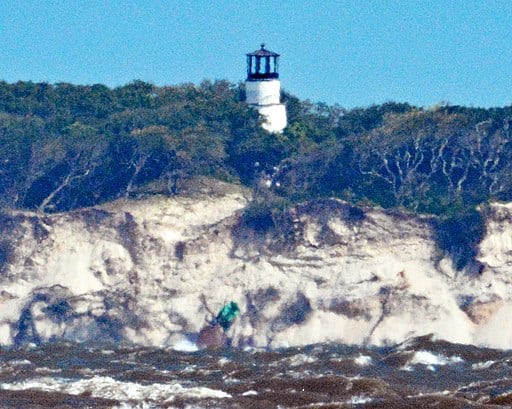
This is the only privately owned lighthouse in Georgia. It’s located on the north end of Little Cumberland Island, adjacent to main Cumberland Island on the Southeast coast of Georgia. The 60-foot lighthouse was built in 1838, The lighthouse was in service until 1915 when it was deactivated. The keeper’s dwelling, and lighthouse station buildings, are long gone but the lighthouse remains in good condition thanks to its dedicated owners.
The Lighthouse and surrounding property are privately owned and not open to the public. A large dune protects the lighthouse and makes it barely visible from the ocean.
You may also enjoy reading my first lighthouse post, History of the Lighthouse.
In conclusion…
The coast of Georgia is very unique with its beautiful marshes that stretch out for miles! The lighthouses there are a bit difficult to reach but it’s worth the effort. It does make me sad that so many southern lighthouses were damaged or destroyed during the Civil War. They stand as majestic historical markers. I call them “Guiding Lights” because anyone who has been on the sea for a long time, such as the mariners of the past, needs these lights to get them safely back home.
Please comment below, I would love to hear about your lighthouse stories and adventures! Remember to share this post with your family and friends on social media.
You will find more information on Georgia’s Lighthouses on the Explore Georgia website.
*If you would like to receive more information about travel destinations, campground reviews, and our daily adventures, please click HERE. When you provide your email address, you will receive our weekly newsletters directly in your inbox! We also have a free printable for you!*
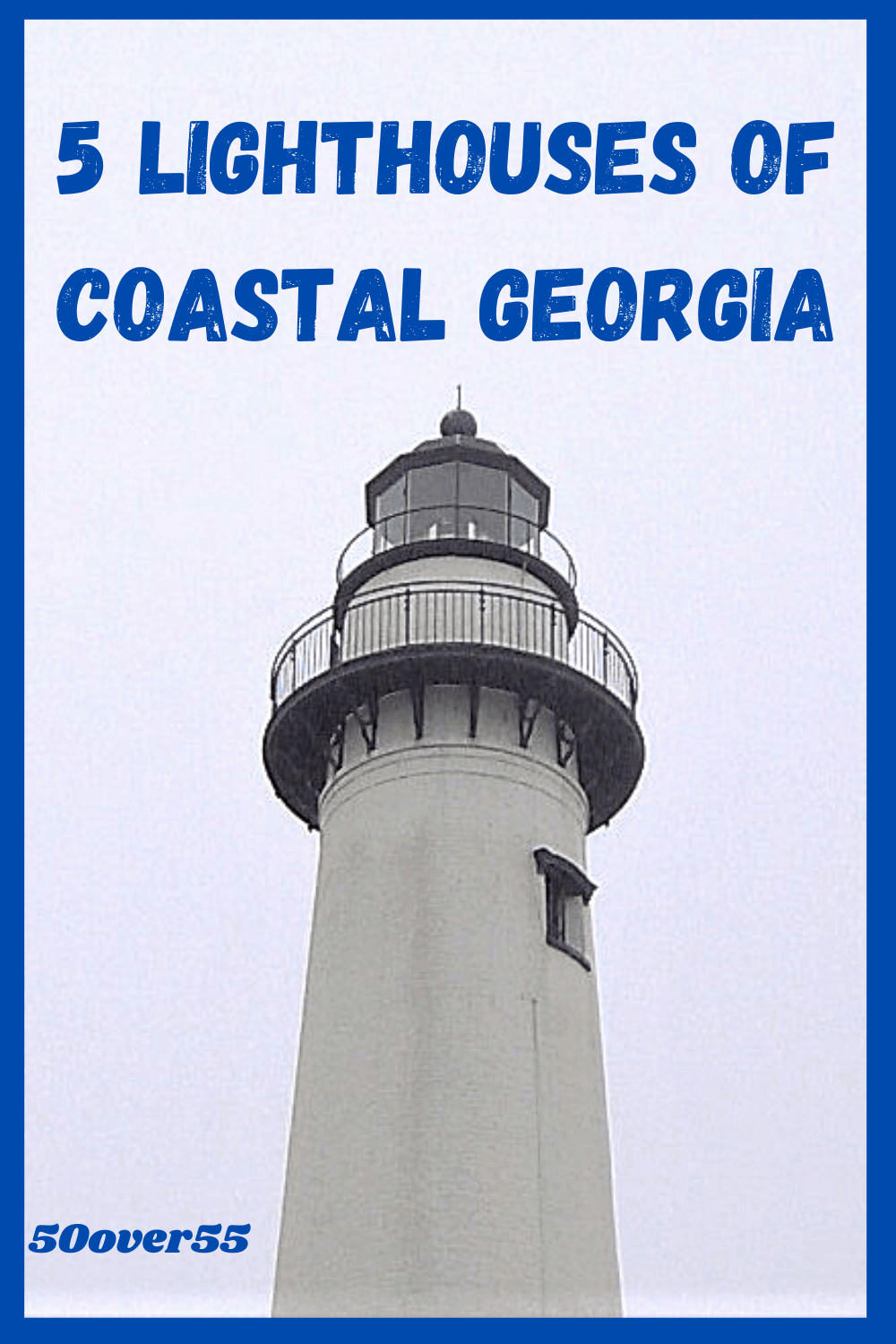

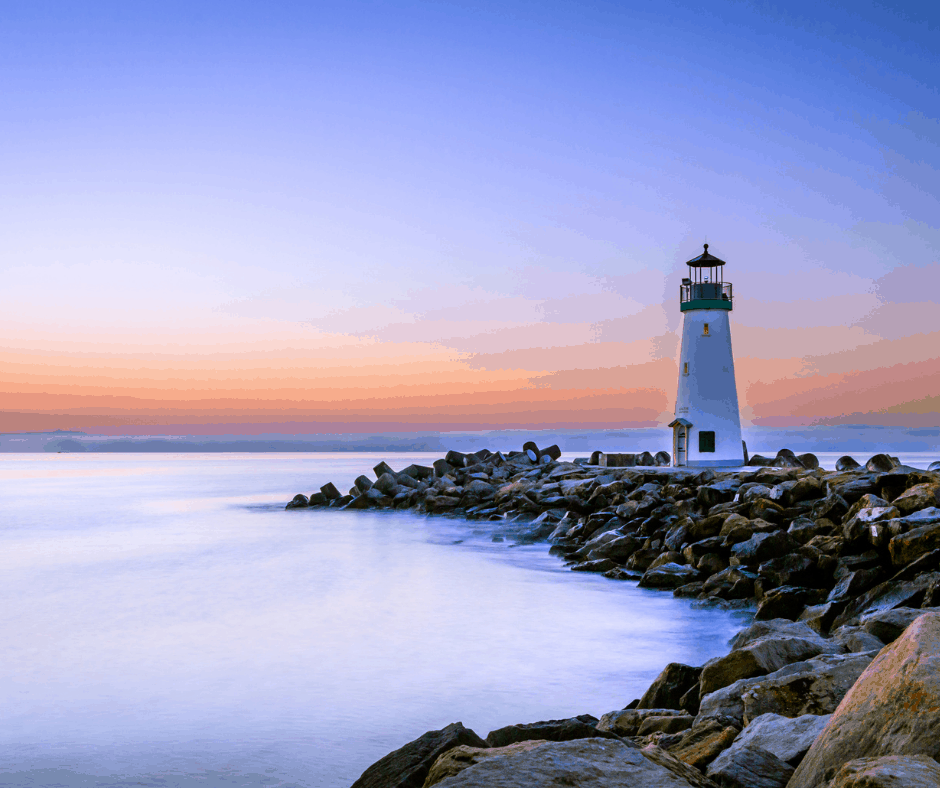
Nice hotels with a view of one of those Tybee Island lighthouses would definitely be wonderful for me! I’m looking for a nice spot to stay at https://visittybee.com/article/history-of-tybee-island-lighthouse, and perhaps I’ll obtain some beautiful images like those on this site!
Thanks for the information. I think it would be a great vacation spot!
I really enjoyed reading this fascinating post and looking at your photos. Lighthouses have such a rich history and these are especially interesting ones along the coastline of Georgia. I live in Scotland and a few years ago, on my birthday, my husband took me to stay in a lighthouse on the west coast that is now a hotel. I loved it! Kindest regards, Janice
Staying in a lighthouse is so cool! I bet you had a great time! Thanks for reading
Love your post. Great pictures of lighthouses – guiding lights. Thanks for sharing.
Thanks! I love lighthouses!
I’ve been to Georgia many times but never to the coast (even in Savannah, haha). These are beautiful and I’m sure it made a great trip! That Cockspur Island lighthouse is incredible!
It is a beautiful area of Georgia, and I love lighthouses!
The coastal lighthouses of Georgia looks beautiful. I love lighthouses. The view is always breathtaking from them. I will try to visit some them when I am near Georgia.
Thank you for sharing interesting facts about them.
I love lighthouses too! I hope you can see these someday!
Thanks for the great post. I am glad that at least some of the lighthouses are still there. So much history which makes it really interesting.
Thanks for reading!
Love Lighthouses! We were in Georgia for such a short time that they did not make the cut. But if we ever get back, it will be on the list!
Great! I haven’t seen them all, but we will get there one day!